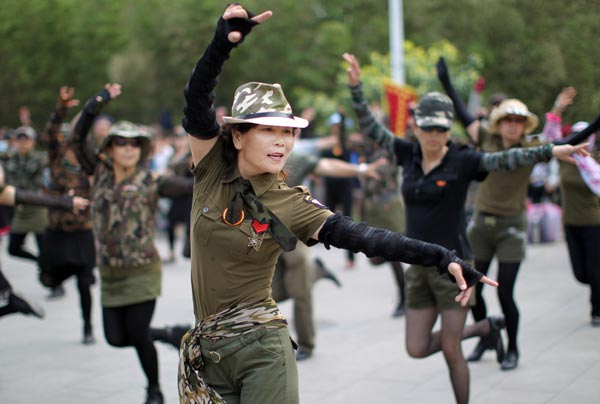
Dancers at a park in Beijing wear clothes inspired by military uniforms. Square dancers attract crowds of spectators by wearing colorful costumes and choreographing their own steps. (Photo: Zou Hong/China Daily)
Day and night across China, groups of middle-aged, retirees, mostly women, gather together to dance in open spaces, such as parks and public squares. They are known as guang chang wu da ma, or "public square dance older ladies", as literally translated. Their passion for square dancing has made them a national phenomenon but they are also a source of controversy, with complaints that their music is too loud, they occupy too much public space and they occasionally use inappropriate venues-such as the square in front of the Louvre in Paris, where Chinese tourists broke into a dance last year.
But controversy aside, the dancers are only growing in number and style. Some groups of dancers have even begun to attract crowds of spectators by wearing colorful, flamboyant costumes and choreographing their own steps in distinctive styles.
Some of the dancers have made headlines, such as the group of older women who donned military uniforms, held toy guns and danced like soldiers to patriotic songs in a square in front of a shopping mall near Dongzhimen, downtown Beijing recently.
Li Dong, 46, is a pioneer in this field. Every day from 9 am to 11:30 am, she leads a group of amateur dancers at the north gate of Tao Ran Ting, a park near the South Second Ring Road in Beijing. They wear camouflage T-shirts, navy blue shorts and fishnet stockings. Their moves mix elements of jazz, Latin and swing dance and each routine has been choreographed by Li.
"In addition to keeping fit, square dancing has become so popular so quickly because older people who are free from work and from raising children want to be connected with one another. But I think that square dancing has a deeper meaning," says Li.
Li, a former public servant from the Inner Mongolia autonomous region, moved to Beijing with her family in 2008. She started square dancing in the summer of 2012. She cured her slipped disk through dancing and founded her own dance team in November 2013. Now, her team has nearly 1,000 people, aged from 40 to 80.
"I wanted to make my dance team special and different from the others because I realized that older people want to display themselves. They easily get bored with simple, regular movements. With eye-catching clothes and beautiful steps, they have fun and feel confident and young again," she says.
By teaching herself different dances, such as Latin, Tango and cha-cha, Li adds variety to square dancing. She has created five dance pieces.
"Don't underestimate the creativity of older people, we are curious and want to try different dance styles," she adds. "Because square dancing has attracted so much attention, I want to take it seriously."
Like Li, Zhuang Yun, 57, is a big fan of dance. She also interprets square dancing in her own way.
In 2012, the former journalist from Chongqing, Sichuan province, founded her dance team. For Zhuang, besides a healthy pastime, square dancing also means a sense of enjoyment, social engagement and reconnecting with creativity.
She choreographed a series of routines that she adapted from traditional Chinese folk dances, such as the lotus dance, which sees Zhuang and her team wearing fluffy, lotus-shaped dresses while holding lotus-shaped lanterns.
"Most of our members are in their early 50s. They are recently retired and are passionate about dancing. We not only entertain ourselves but also perform for older people in nursing homes," says Zhuang, who has about 900 team members and dances every day in a park near Andingmen in Beijing.
A new regulation from the General Administration of Sport of China and the Ministry of Culture has again put square dancing in the headlines.
To regulate and promote square dancing, the government has mapped out rules stating where seniors can dance and how loud their music can be. Twelve officially choreographed square dance steps have also been released, which are accompanied by popular songs, such as Little Apple, China is Beautiful and The Most Dazzling Folk Style.
"I think those rules are for beginners. People who have years of square dancing experience, like me, don't need those instructions. We are capable of designing our own dances," says Li.
She says her team has taken the suggestion of turning down the volume and dancing at proper sites. "We are not a threat at all," she says.
According to Du Peng, chief of the Institute of Gerontology at Renmin University of China, the popularity of square dancing reflects a psychological change among China's rapidly aging society.
"Elderly people in China are much more educated nowadays. They feel free to explore more ways to entertain themselves," Du says.
Li's next goal is to learn to break-dance, which she will incorporate into her new square dance routines. On March 26, the China Dancers Association released the first official teaching textbook of China Street Dance Art and Education Level Test, covering six dance styles, including breaking, popping and hip-hop.
"I cannot wait to dance with my team in loose pants and big T-shirts," says Li. "With square dancing, we have our own stage."
















































